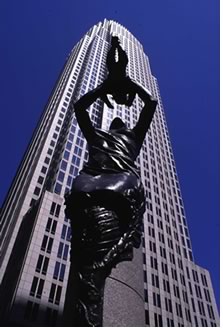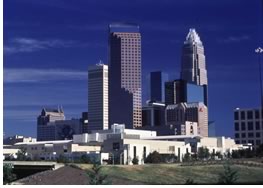
 As
is traditional, the AIA National Convention and Expo—held this year
in Charlotte, May 9–11—will offer theme presentations, workshops,
and seminars designed to enhance the work of architects and building professionals.
This year, in part to honor the host city's prominence as a financial
center, the convention will offer numerous opportunities to explore the
significant impact financial institutions have on the economy and societal
well-being.
As
is traditional, the AIA National Convention and Expo—held this year
in Charlotte, May 9–11—will offer theme presentations, workshops,
and seminars designed to enhance the work of architects and building professionals.
This year, in part to honor the host city's prominence as a financial
center, the convention will offer numerous opportunities to explore the
significant impact financial institutions have on the economy and societal
well-being.
McColl to serve as
keynoter
On Friday, May 10, keynote speaker Hugh L. McColl Jr., former chair and
CEO of Bank of America Corporation-one of the largest, fastest-growing
U.S. financial institutions—will discuss the relationship between
financial organizations, architecture, and community. During his 18-year
tenure, McColl guided Bank of America (and, prior to that, Nations Bank)
in record growth, acquiring more than 50 companies, serving 30 million
households and two million businesses in 22 states and 38 countries, and
employing almost 180,000 people.
McColl also is a passionate advocate of good design, smart growth, and, especially, urban design. He led Bank of America to reinvest its resources ($350 billion) in economically underserved communities through community development, affordable housing lending, and corporate philanthropy to support public education and the arts. McColl has been the catalyst for much of Charlotte's urban evolution and renewal, including numerous residential projects that have brought thousands of residents to the city center.
 Further
financial exploration
Further
financial exploration
Throughout the convention, you will have an opportunity to explore community
investment and revitalization through a number of professional workshops,
seminars, and tours:
• "Urban Schools: Developing Humane and Supportive Environments
Within an Urban Fabric" seminar will examine innovative approaches
that efficiently use limited resources and result in multiple uses of
land and facilities
• "Justice by Design: The New Urban Courthouse" seminar
will explore how new federal and state courthouses address urban design
solutions, civic engagement, security, sustainability, and energy efficiency
• "Reaching for the Triple Bottom Line—A Sustainable Community
Revitalization" will discuss a 3,000-acre section of North Charleston,
S.C., that currently is being revitalized into an environmentally, economically,
and socially sustainable community by a collaborative partnership among
the city, developer, and master-planning team
• "Case Studies in Urban Design Process" seminar will look
at the process as governed by economic, political, cultural, and environmental
factors
• "Behind the $cenes. Gateway to Charlotte's Center City"
is a tour to Gateway Village for a behind-the-scenes look at two of the
country's largest financial institutions—Wachovia and Bank of America
• "Where There's Money to Burn" is a tour of the Federal
Reserve Bank's Charlotte Branch.
Register early and
save $100
Register by April 12, 2002, and save $100-and increase your chances of
getting the workshops, tours, special events, programs, hotel accommodations,
and airfare you want. For the most up-to-date convention information,
and to register online, visit www.aia.org. For information on conference
registration or to book exhibit space, call M|C Communications, 617-859-4475.
This article was prepared by M|C Communications, the AIA's convention consultant.
|
What Where When Information/ |
|
|
Charlotte's Proud History Founded in 1768, Charlotte has enjoyed a reputation for rugged individualism since its inception. Settlers named the town to honor England's Queen Charlotte (wife of the newly enthroned King George III) and named the surrounding county for her native land, Mecklenburg, Germany. Today, Charlotte is still known as the Queen City, and the city's tallest building, the Bank of America Tower, is adorned with a crown as a nod towards the city's history. From its modest beginnings as a small village, Charlotte quickly attained city status with America's first gold discovery in 1799. This was also the first step in establishing the city as a financial center. Charlotte was the country's gold mining capital until the California Gold Rush some 50 years later, hence the presence of the Federal Reserve. However, the driving force propelling business activities was the arrival of the railroad. Charlotte's location provided a centralized marketplace, industrial center, and transportation hub for the surrounding Piedmont farming communities. Today, with $855.5 billion in assets, Charlotte is the second largest financial center in the nation (New York City is the largest). Two of the nation's largest banks, Bank of America and Wachovia, are headquartered here. In total, it is home to 20 banks in addition to the Federal Reserve Branch, providing services to commercial and individual customers. |
||
Copyright 2001 The American Institute of Architects. All rights reserved.
![]()